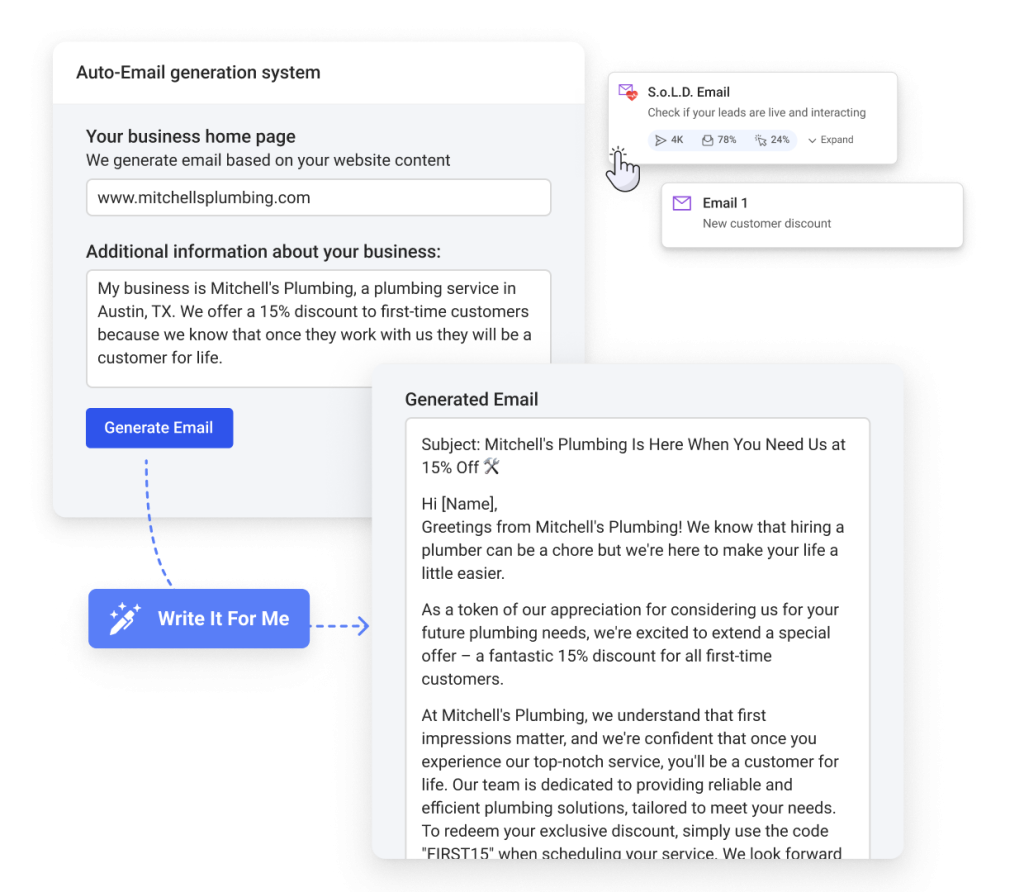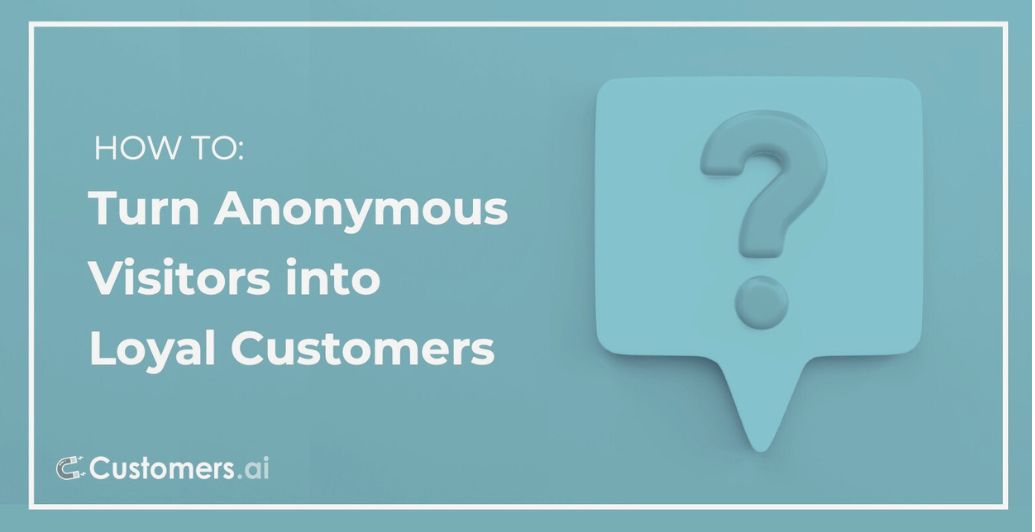Loyalty. It’s something all brands dream of. It’s the goal and it’s often the key to success.
Don’t believe me? Check out this chart from Yotpo based on their study “The State of Customer Loyalty & Retention 2023”:

It seems the real question here is, what wouldn’t brand-loyal customers do?!?
While brand loyalty is something everyone wants, it’s not easy to get. It takes time, resources, a commitment to understanding your customers, and data.
Data being the key.
To understand your customers, and to give them the warm and fuzzy feelings they need, you must have data about them.
And that’s where website visitor identification comes into play.
Convert Website Visitors into Real Contacts!
Identify who is visiting your site with name, email and more. Get 500 contacts for free!
The Challenge of Anonymous Visitors
When it comes to running an online business, anonymous website visitors present a real problem.
These visitors, despite showing interest in your products or services, remain frustratingly unknown. And not just a few – 97% of them are unknown!

That is a lot of people to be missing out on and without the means to identify them, you’re left in the dark when it comes to tailoring your marketing efforts or providing them with personalized recommendations.
The anonymity not only makes it difficult to understand their preferences and needs but also leaves you clueless about where they are in their buying journey. As a result, you end up missing out on opportunities to guide them through the purchase process and transform them into loyal customers.
What’s more, the revenue losses associated with anonymous traffic are nothing to scoff at.
How to Turn Anonymous Visitors into Loyal Customers with Website Visitor Information
At the most basic level, website visitor identification involves collecting and analyzing data about your website visitors.
This data can be an absolute game-changer, especially when it comes to building customer loyalty.
Think about it – with information on who your visitors are and what they want, you can actually tailor your marketing strategies, product promotions, and engagement tactics to the individual.
Just like everything else in marketing though, it’s not just about having the data. You need to actually use the data.
To put this into action, you’ll need to roll up your sleeves and take some practical steps. Let’s dig in.
Create Comprehensive Customer Profiles
You can’t personalize your messaging if you don’t know the person. Detailed customer profiles are essential for 1-to-1 marketing, sales strategies, and customer service excellence.

The more complete a customer profile, the easier it is to anticipate customer needs, tailor their communications, and build those connections that drive loyalty.
When it comes to building a comprehensive customer profile, consider the following:
- Go Beyond the Basics: It’s no longer enough to gather basic information from your website visitors (i.e. location, device used, and browsing behavior). To create a great customer experience that drives brand loyalty, you need more. Website visitor identification can give you names, emails, business emails, company names, referral sources, pages visited, and more.
- Real-Time CRM Integration: The time to reach that customer or prospect isn’t 7 days after they visited your site. By then, they’ve already moved on or rethought their purchase. You need to make sure the information you are capturing goes directly into your CRM, enriching your contact data and expanding customer profiles in real-time.
- Segment Early: Not every person who visits your site is a high-value lead. While website visitor identification tools can give you names, emails, etc., that doesn’t mean you should immediately email them all. Don’t do that. Use the customer data you have to create segments. Think about it this way, cart abandonment works because that is a high-intent action. Visiting a blog post isn’t and shouldn’t be marketed to the same.
The more accurate and more complete your customer profiles are, the better your marketing will be.
Personalize Messaging to Drive Engagement
As marketers, communication is all we have. And good communication is about understanding our audience and addressing them in a way that resonates. A way that engages them.

By taking our anonymous visitors and actually learning about them, we can find ways to engage them. It boils down to segmentation and personalization.
Segment for Success
We touched on segmentation as it relates to customer profiles. The next piece of that is using those segments to create the appropriate messaging. To ensure we are hitting our customers at the right point in their journey, with the right piece of content, in the right place.
Using website visitor data, we can segment our audience into distinct groups. These groups might be based on browsing habits, demographic data, or past purchases. The key is categorizing them into the right groups for more effective communication.
For example, if you are using the Customers.ai Website Visitor ID X-ray pixel to capture visitors to your site, you can’t market to them all the same way. Not every visitor should be put into your email automation or existing nurturing campaign. They must be segmented.
Here’s a way to think about it:
- High-Intent Prospects: Individuals who are already familiar with your brand. They visited a request a demo page, abandoned a shopping cart, or opened a product-specific email. These people can be put into outreach campaigns as they have engaged with purchase intent.
- Low-Intent Prospects: These are individuals who maybe came to your site for the first time. You don’t have any existing information on them and they didn’t visit a high-intent page. Do not email these folks. You will scare them and any chance of building loyalty will be gone. These are the people that are perfect for remarketing campaigns. Create segments around pages they visited. Did they visit a particular product page? Remarket to them with that product. As they engage more and more, you can start moving them further into the funnel.
- Medium-Value Prospects: These are people who you already have some data on. Perhaps they’ve visited the site more than once, browsed a specific product a few times, but have never taken any sort of action. These people are perfect for the Signs of Life Detector. This will send them a welcome email to find out if they are actually interested in hearing from you via email. If not, throw them back into your remarketing campaigns and continue to nurture the relationship.
- Returning Customers: Already a customer? If they come back to the site and don’t make a purchase, why not send them a coupon or an email about an upcoming VIP only sale? Use this opportunity to make them feel special.
At the end of the day, the better you can segment your customers, the better your messaging will be.
Personalize it All
With specific segments in hand, our messaging can be finely tuned and we can start personalizing our communications. Let’s take a look at a few examples of how this can happen:
- Personalized Email Marketing: Use your segments to create tailored emails. For example, incorporate specific products, mention sales, or show them complementary products. With individuals receiving an average of 120+ messages per day, one that speaks to their interest is needed to stand out.
- Strategic Social Media Advertising: We mentioned retargeting earlier and we’ll mention it again. Retargeting is a great way to reach your audience without scaring them off or being too pushy. Use your visitor data to target users on social media with ads that align with their recent site activity. It demonstrates an understanding of what they like and responsiveness to their interests.
- Dynamic Landing Pages: By adapting your website’s landing pages to reflect the interests of returning visitors, you can create a more relevant and engaging user experience. If a visitor frequently browses a certain category, customizing the homepage to highlight similar products can be highly effective.
Segmentation and personalization are more than trends; they are necessary for building and growing lasting customer relationships.
Ecommerce Webinar

Beyond Abandoned Cart to Abandoned Product View Revenue
with Email Deliverability Hacks & AI Tools
Post-Purchase Engagement Matters
When it comes to loyalty, the real magic happens after the purchase. As we mentioned earlier, website visitor identification can help you fill in the gaps and complete those customer profiles – the result? Better post-purchase outreach.
Beyond prospects and leads, the more data you have on your customers, the better chance you have of creating return customers and loyal customers. Let’s look at how:
1. Personalized Follow-Up Communication
After a purchase, personalized follow-up is key. This can include thank-you emails, satisfaction surveys, personalized recommendations, or even general tips based on their purchase or customer profile.
Amazon does this exceptionally well. After a purchase, they send personalized emails suggesting related products and asking for feedback. This not only encourages repeat purchases but also helps in gathering valuable customer feedback.
Another example of this is JetBlue. When you book a flight, follow-up emails will include things to do, car rental and hotel information, and more. All content that is helpful to your trip.
2. Exclusive Access to Loyalty Programs
Offering customers exclusive access to loyalty programs or members-only perks post-purchase can significantly enhance engagement and encourage repeat business.
A well-known example is Sephora’s Beauty Insider program. Customers earn points for each purchase, which they can redeem for rewards. They also get access to exclusive sales and events, making them feel valued and increasing their likelihood to repurchase.
3. Social Media for Continued Engagement
Engaging with customers on social post-purchase can foster a community feeling and keep your brand at the forefront of their minds. This can include sharing user-generated content, offering post-purchase tips, or hosting community events.
Nike does something really cool with their Nike Training Club. Post-purchase, customers are invited to join their online community where they can share achievements, participate in challenges, and get tips on using their products. This not only strengthens the customer-brand relationship but also turns customers into brand ambassadors.
While these are just a few examples of how to drive post-purchase engagement, it’s important to remember the key to brand relationships is staying top of mind, giving customers what they are interested in, and being useful.
Start Turning Those Anonymous Visitors Into Loyal Customers
And there you have it! By harnessing the power of website visitor identification, crafting personalized engagements, and nurturing post-purchase relationships, you’re well on your way to transforming anonymous visitors into loyal customers.
Remember, every click, every purchase, and every interaction is an opportunity to deepen that connection. So, let’s start turning those casual browsers into your brand’s biggest fans.
Important Next Steps
- See what targeted outbound marketing is all about. Capture and engage your first 500 website visitor leads with Customers.ai X-Ray website visitor identification for free.
- Talk and learn about sales outreach automation with other growth enthusiasts. Join Customers.ai Island, our Facebook group of 40K marketers and entrepreneurs who are ready to support you.
- Advance your marketing performance with Sales Outreach School, a free tutorial and training area for sales pros and marketers.
Convert Website Visitors into Real Contacts!
Identify who is visiting your site with name, email and more. Get 500 contacts for free!
